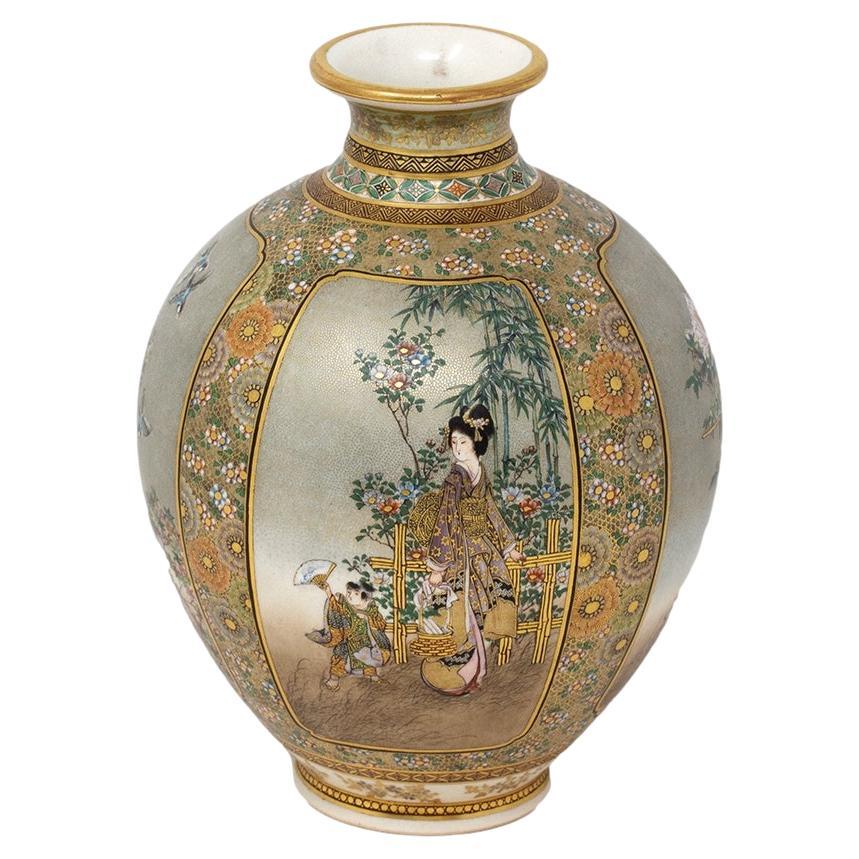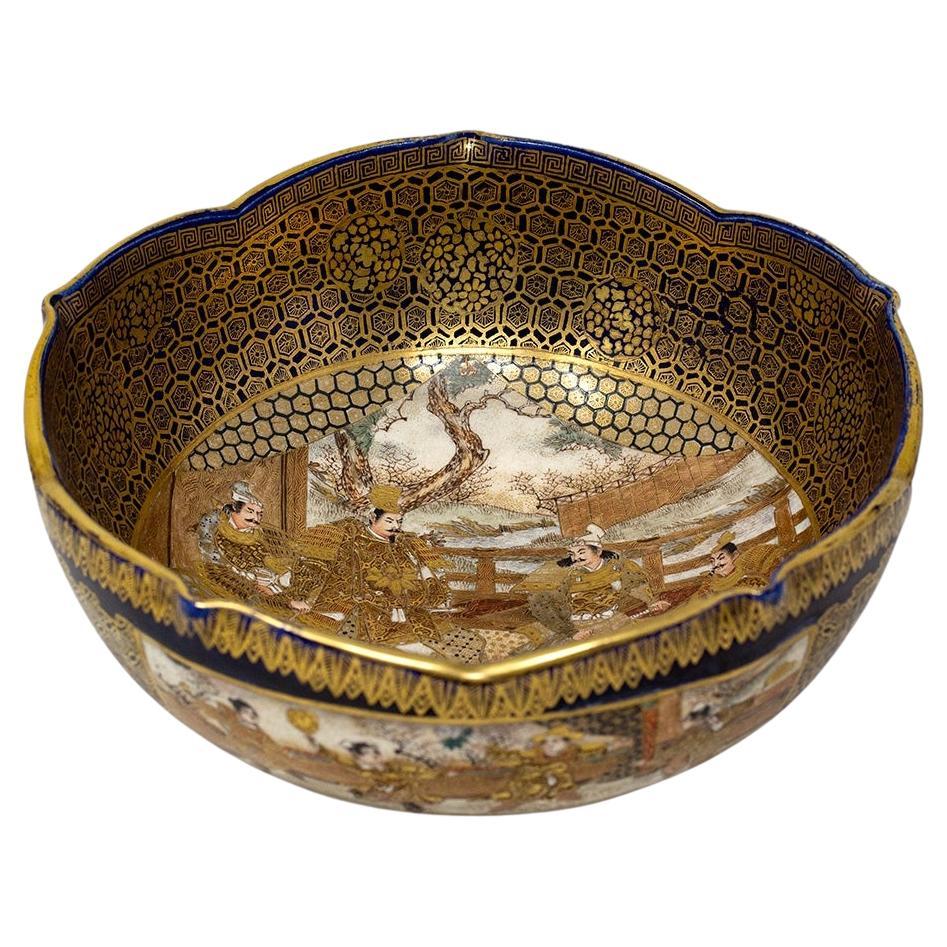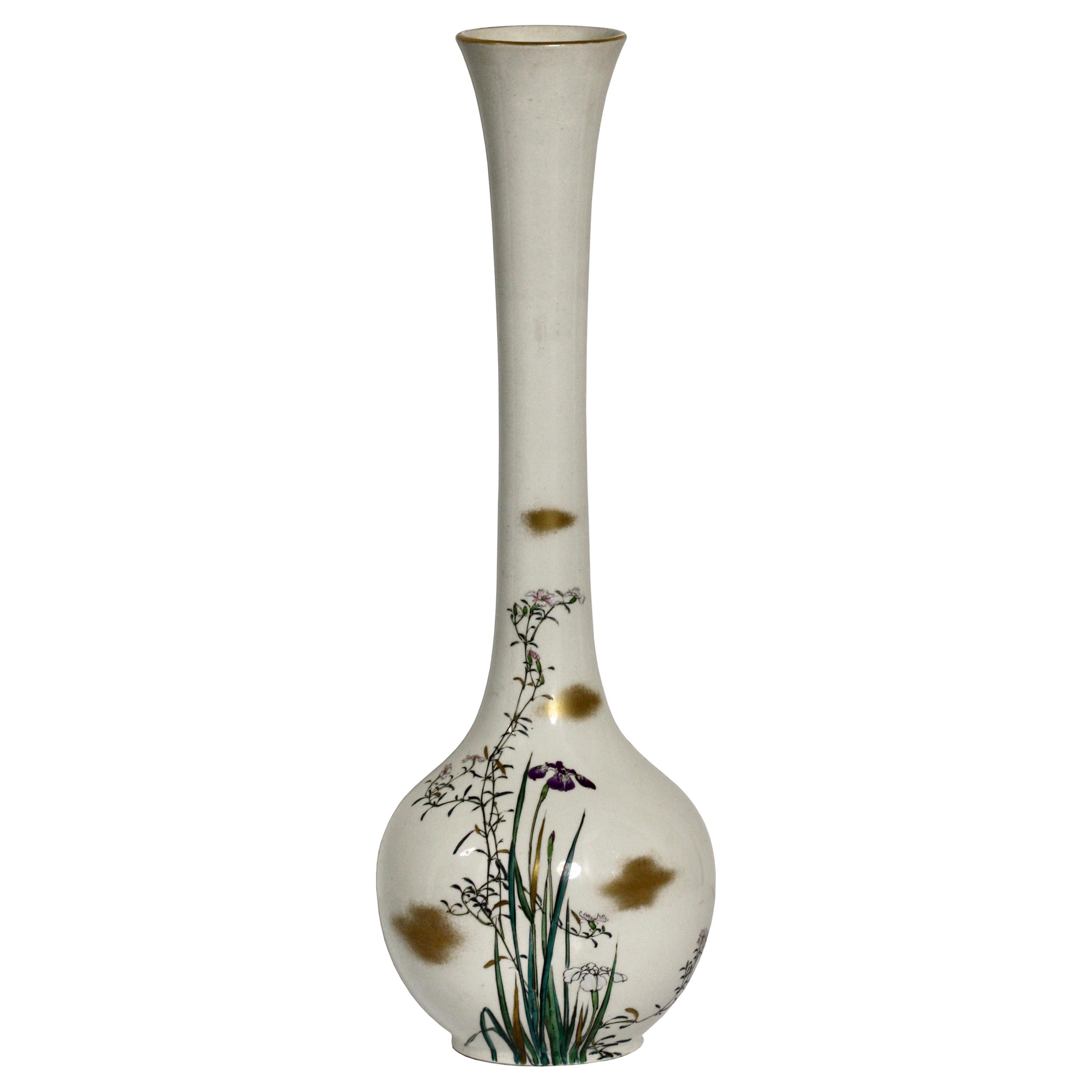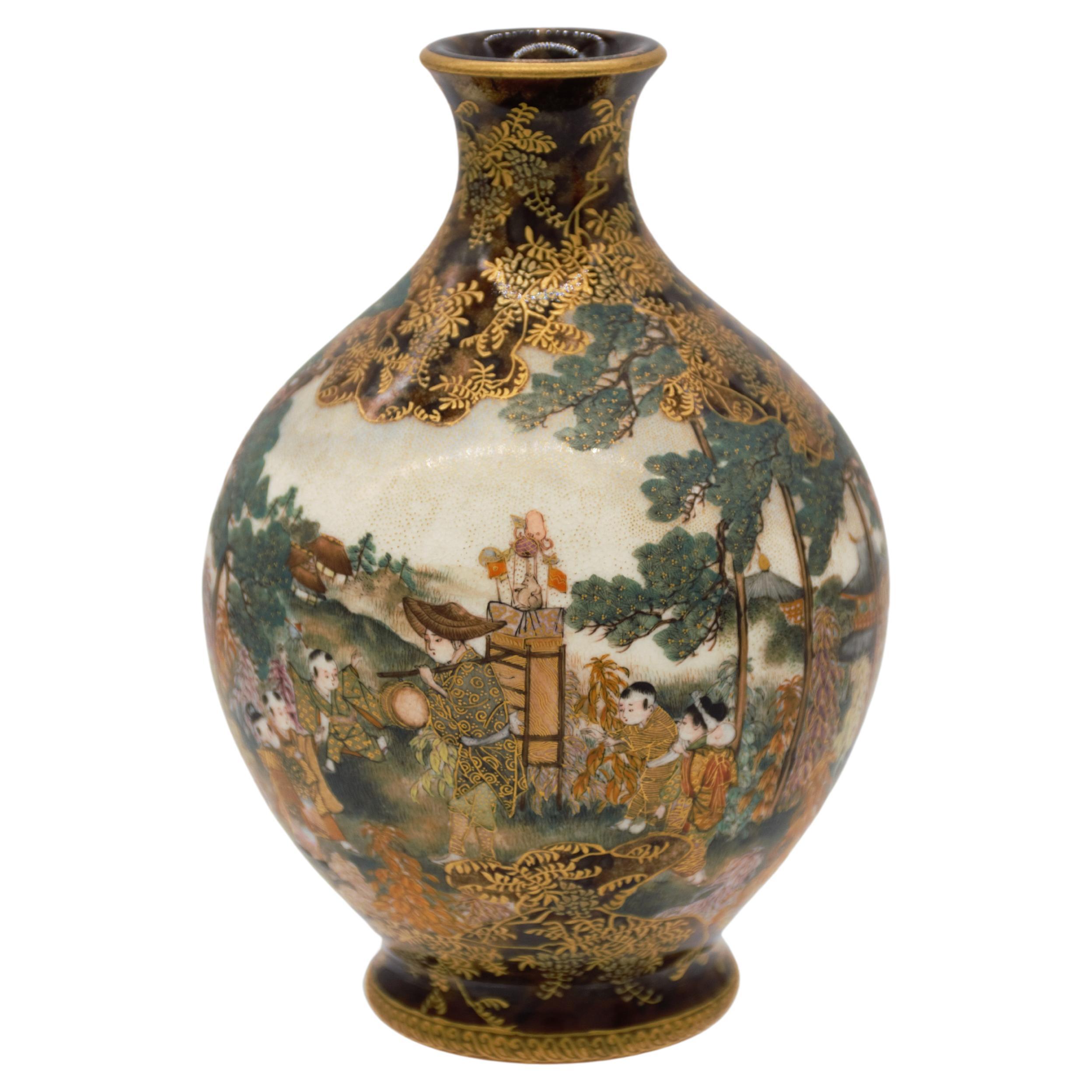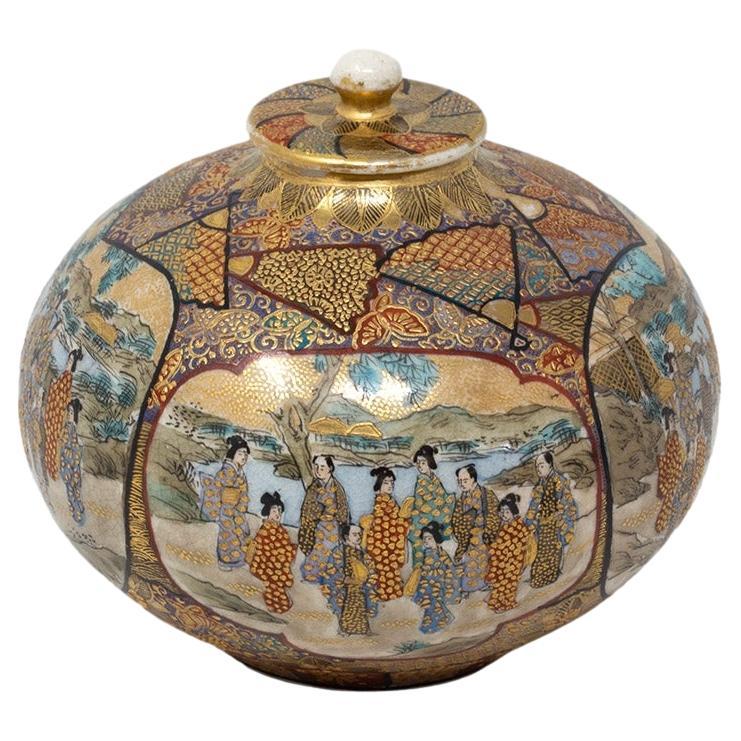Items Similar to Japanese Meiji Period Satsuma Plate by Kinkozan
Want more images or videos?
Request additional images or videos from the seller
1 of 17
Japanese Meiji Period Satsuma Plate by Kinkozan
About the Item
Painted with Two Snipe Amongst Iris
From our Japanese collection, we are delighted to offer this Japanese Meiji Period Satsuma Plate by Kinkozan. The Satsuma Plate is extensively decorated with a central scene featuring two common snipe birds stood in a pool of water fishing amongst green stemmed iris flowers having colours of blue, purple, red and cream. The scene is framed by a richly decorated border with a cobalt ground base and gilded flowers with coloured petals. The outer rim bordered with detailed gilded flowers in a tight parallel border finishing the front of the plate. The rear of the Satsuma Plate has a cobalt wash to the outer face and is signed to the centre of the plate with a four character Kinkozan zo mark 錦光山 above an original S.Kinkozan (Sobei Kinkozan), Kyoto, Japan retailer sticker with stock code. The rear of the plate also features a Kinkozan blind mark stating that the plate was an original Kinkozan workshop potted plate and not bought in and finally a collectors label. The Satsuma Plate dates to the Meiji Period (1868-1912) and the first quarter of the 20th century circa 1885.
The Satsuma Plate will be sent with the accompanying stand seen in the decorative photo.
Kinkozan the Kinkozan family have been associated with pottery dating back to 1645. They went on to become the largest producer of Satsuma ware by one individual company, from the end of the 19th century until 1927 after which the factory closed. By the 1850s Kobayashi Sobei (1824-84), Kinkozan Sobei (artist name Kinkozan IV), started to export his products together with the Kyoto manufacturer Taizan VIII. The main target market was America with their main production period approximately between 1875-1927 under the leadership of Kinkozan V(1868-1927).
Meiji Period was an era of Japanese history that spanned from 1868 to 1912. It was the first half of the Empire of Japan, when the Japanese people began to build a paradigm of a modern, industrialised nation state and emergent great power, influenced by Western countries and aesthetics. As a result of radically different ideas, the changes to Japan were profound and it affected the social structure, politics, economy, military, and foreign relations across the board. The period corresponded to the reign of Emperor Meiji and was preceded by the Keio era and was succeeded by the Taisho era.
Cultural Art during the Meiji Period was of particular interest to the government and they overhauled the art export market which in turn promoted Japanese arts via various world’s fairs, beginning in Vienna at the world fair in 1873. The government heavily funded the fairs and took an active role organising how Japan’s culture was presented to the world including creating a semi-public company named Kiritsu Kosho Kaisha (First Industrial Manufacturing Company). The Kiritsu Kosho Kaisha was used to promote and commercialise exports of Japanese art and established the Hakurankai Jimukyoku (Exhibition Bureau) to maintain quality standards. For the 1876 Centennial International Exhibition in Philadelphia, the Japanese government created a Centennial Office and sent a special envoy to secure space for the 30,000 items that would be displayed. The Imperial Household also took an active interest in arts and crafts, commissioning works by select artists to be given as gifts for foreign dignitaries further emphasising the high quality and importance of Japanese art. Just before the end of the 19th century in 1890, the Teishitsu Gigeiin (Artist to the Imperial Household) system was created to recognise distinguished artists. These artists were selected for their exceptionally high quality wares and talent in their own industry. Over a period of 54 years Seventy artists were appointed, amongst these were ceramicist Makuzu Kozan and cloisonné enamel artist Namikawa Yasuyuki.
Satsuma ware is a type of earthenware pottery originating from the Satsuma province in Southern Kyushu, Japan’s third largest island.
Antique a collectable object such as a piece of furniture or work of art that has a high value because of its age and quality. Objects of this nature are generally considered antique at 100 plus years of age.
About the Seller
5.0
Vetted Seller
These experienced sellers undergo a comprehensive evaluation by our team of in-house experts.
Established in 2019
1stDibs seller since 2022
18 sales on 1stDibs
Typical response time: 1 hour
- ShippingRetrieving quote...Ships From: Newark, United Kingdom
- Return PolicyA return for this item may be initiated within 14 days of delivery.
More From This SellerView All
- Japanese Meiji Period Satsuma Vase by KinkozanBy KinkozanLocated in Newark, EnglandThe vase is potted in globular form with a tightly pinched neck and rolled top rim beautifully decorated with four highly detailed individual panelled scenes. The first a Geisha bari...Category
Antique Late 19th Century Japanese Meiji Ceramics
MaterialsCeramic, Earthenware, Pottery
- Japanese Meiji Period Satsuma Bowl KinkozanBy KinkozanLocated in Newark, EnglandFrom our Japanese collection, we are delighted to offer this Japanese Meiji period Satsuma Bowl by Kinkozan. The earthenware bowl with pinched rim extensively decorated on both the exterior and interior. The bowl with a cobalt blue base glaze decorated to the borders with gilt shippo-tsunagi (linked-cash) with scattered medallion roundells. Around the exterior two elongated scenes are featured, one with boys playing games in a courtyard with the other featuring seated scholars in full dress both with raised enamel decoration. The interior features a central scene with Samurai warriors in training fully armoured with swords in a courtyard with landscapes scenes to the background. The central scene bordered by further stylised shippo-tsunagi type decoration with a greek key rim border. The bowl signed to the base Kinkozan dating to the Meiji Period (1868-1912) circa 1900. Shippo-Tsunagi (linked-cash) or seven treasures, is a traditional Japanese geometric pattern that combines four ellipses in a circle. These ellipses repeat outward to then create more circles, symbolising eternal peace and happiness. Kinkozan the Kinkozan family have been associated with pottery dating back to 1645. They went on to become the largest producer of Satsuma ware by one individual company, from the end of the 19th century until 1927 after which the factory closed. By the 1850s Kobayashi Sobei (1824-84), Kinkozan Sobei...Category
Antique Early 1900s Japanese Meiji Ceramics
MaterialsCeramic, Earthenware, Pottery, Faux Leather
- Japanese Meiji Period Satsuma KoroBy KinkozanLocated in Newark, EnglandBulbous Form From our Japanese collection, we are delighted to offer this Japanese Meiji Period Satsuma Koro. The Japanese Satsuma Koro of rounded form neatly potted with a small to...Category
Antique Early 1900s Japanese Meiji Ceramics
MaterialsCeramic, Earthenware, Pottery
- Japanese Hand Painted Meiji Period Satsuma VaseBy KinkozanLocated in Newark, EnglandSquat Bulbous Form From our Japanese collection, we are delighted to offer this Japanese Meiji Period Satsuma Vase. The Satsuma vase of squat bulbous form with a tightly pinched nec...Category
Antique Late 19th Century Japanese Meiji Ceramics
MaterialsCeramic, Earthenware, Pottery
- Japanese Meiji Period Satsuma Bowl Signed SuizanLocated in Newark, EnglandJapanese Meiji period satsuma scalloped shaped bowl. The bowl of beautiful form with gilt pin-striping and dotting to the accented areas. The exterior decorated with multiple fish swimming around the outside with small flower sprays between. To the inside a painted netting covers the bowl with butterflies and further floral sprays. The centre decorated with representations of each of the woodcut prints from Hiroshige's Tokaido gojusan tsugi (53 Stations of the Tokaido Road). To the base a stylised cartouche signature within an oval for Suizan. This Japanese satsuma bowl...Category
Antique Late 19th Century Japanese Meiji Ceramics
MaterialsCeramic, Earthenware, Pottery
- Antique Japanese Meiji Period Satsuma Koro KizanLocated in Newark, EnglandMeiji Period (1868-1912) From our Japanese collection, we are pleased to offer this Antique Japanese Meiji Period Satsuma Koro by Kizan. The Koro of squat bombe form raised upon an...Category
Antique 1890s Japanese Meiji Ceramics
MaterialsCeramic, Earthenware
You May Also Like
- Kinkozan, Japanese Satsuma Vase, Meiji PeriodBy KinkozanLocated in West Palm Beach, FLKinkozan, Japanese Satsuma vase, Meiji Period (1868-1912) Of baluster form with an elongated neck decorated in polychrome enamels and gilt on a clear crackle glaze in an Art-Nouvea...Category
20th Century Ceramics
MaterialsCeramic
- Satsuma earthenware vase by kinkozan, Meiji periodBy KinkozanLocated in Tel Aviv - Jaffa, ILthe body of this small marvelous vase is painted with a scene of a puppet show vendor with his wood backpack, on top of the backpack there are toys and dolls, he is surrounded with a group of 6 children, and on the background you can see a village. on the other side of the vase there is an amazing painting of flowers and on the sides there are two amazing strong pine trees, the amorphous background is decorated in a "Tortoiseshell" color and design that gives it a real character and which is quite rare to see on satsuma pottery. all the vase is over richly overpainted over the glaze with gold, which gives it its depth and realism. signed Kyoto Kinkozan zo, and sealed Kinkozan zo Kyoto’s Satsuma: The painting technique used in Kyoto’s Satsuma-style ware is said to be the invention of the sixth generation Kinkōzan Sōbei (1824–1884). The Kinkōzan were a famous family of Kyoto Awataguchi potters who made ceramics that were used at Shōren'in, a temple closely tied to the imperial family, and by the shoguns of the Edo government. In fact the shogun is said to have granted them the name Kinkōzan. With the upheavals at the end of the Edo period, however, and the reforms of the subsequent Meiji government, the potters lost their traditional patrons and had to develop new markets. Just at that time, the visit of a certain Westerner is said to have decided them to embark on overseas trade. By 1870, they had perfected Kyō Satsuma...Category
Antique 1890s Japanese Meiji Ceramics
MaterialsGold
- Pair Japanese Satsuma Plates with Miniature Decoration by KinkozanBy KinkozanLocated in Atlanta, GAA pair of Satsuma ceramic plates made by Kinkozan studio circa 1880-1900s during the late Meiji Period. Each dish features miniature enamel decoration o...Category
Antique Late 19th Century Japanese Meiji Ceramics
MaterialsCeramic
- Large Japanese Satsuma Vase by KinkozanBy KinkozanLocated in Christchurch, GBAs part of our Japanese works of art collection we are delighted to offer this finely decorated Meiji Period (1868-1912), Satsuma vase stemming from the highly regarded Kinkozan stud...Category
Antique Late 19th Century Japanese Meiji Ceramics
MaterialsCeramic
- Satsuma Earthenware Vase, by Kinkozan, Japanese, Meiji PeriodBy SatsumaLocated in West Palm Beach, FLA Satsuma Earthenware Vase, by Kinkozan, Japanese, Meiji period (1868-1912) decorated in polychrome enamels and gilt over a clear, crackled glaze, delicately painted with ladies and men, the reverse with a flowering garden with sprays of flowers, the neck with geometric and floral designs, a band of kifu heads in silver and gilt above the foot, on a midnight-blue ground, signed Kinkozan zo...Category
Antique 1860s Vases
MaterialsEarthenware
- Fine Japanese Satsuma Ceramic Vase by KinkozanBy KinkozanLocated in Christchurch, GBAs part of our Japanese works of art collection we are delighted to offer this finely decorated Meiji Period (1868-1912) Satsuma vase stemming from the highly regarded Kinkozan studi...Category
Antique Late 19th Century Japanese Meiji Ceramics
MaterialsCeramic
Recently Viewed
View AllMore Ways To Browse
Period Face
Meiji Period Furniture
Japanese Meiji Period
Japanese Company
Japanned Finish
Gilded Flowers
Japanese Modern Ceramics
Japanese Influence Furniture
High End Antiques
Antique Japanese Plates Plates
Antique Japanese Plates
Japan Board
Circa Meiji Japanese
Japanese Antique Plate
Japanese Antique Plates
Japanese Modern Plate
Japanese Arts And Crafts
Plates With Two People
